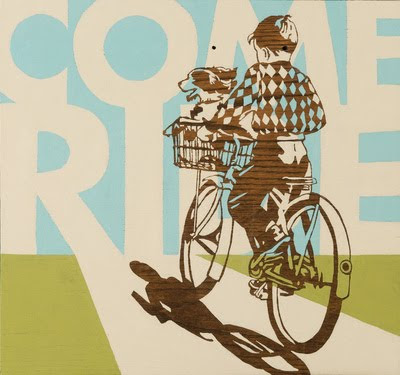Saturday, May 7, 2011
Illusion of Motion by Multiple Images
This piece gives the illusion of motion because the slight changes in each successive position of the man as we walked down the stairs suggests movement taking place.
Anticipated Motion
This shows anticipated motion because we as viewers recognize the subjects' unstable position on the motorcycle and realize that change must be immediate.
Multiple Perspective
This shows multiple perspectives because we're looking at the building from more than one vantage point.
Illusion of Space by Linear Perspective
This shows the illusion of space by linear perspective because the two lines of the road recede to the horizon line, giving the viewer the impression of depth and space.
Illusion of Space by Aerial Perspective
This piece uses value to show depth, making it an example of illusion of space by aerial perspective. The tree in front is dark, making it appear to be closer than the lighter background.
Illusion of Space by Vertical Location
This shows the illusion of space by vertical location because the trees and clouds are higher on the page, giving the illusion that they're farther back in space.
Illusion of Shape by Overlapping
This piece gives the illusion of space because each element is placed in front of another to create a sense of depth.
Scale Confusion
This shows scale confusion because the cupcakes that are replacing the people's heads have obviously been increased in size when placed next the human bodies.
Alternating Pattern
This shows alternating pattern because the color of the birds consistently alternate with one another to produce a regular sequence.
Progressive Rhythm
This shows progressive rhythm because it involves repetition, but it's repetition of the light posts in which the size changes in a sequential manner.
Absence of Focal Point
This shows the absence of a focal point because it seems that the artist chose to emphasize the entire surface of the composition over any individual element.
Degree of Emphasis
This piece shows the degrees of emphasis. The creature in front is the primary focal point, the darker trees secondary, and the light trees/sky are the tertiary focal point.
Emphasis by Placement
This shows emphasis by placement because many elements are pointing to the subject. Our attention is directed there, making it a focal point.
Emphasis by Isolation
This piece shows emphasis by isolation because simply by being alone, the man grabs the viewers attention. There is contrast of placement, not form.
Emphasis by Contrast
This shows emphasis by contrast because the difference in color between the subject and the rest of the piece draws attention to the girl.
Crystallographic Pattern
This piece shows crystallographic pattern because the is equal emphasis over the whole thing. There is the same wight or eye attraction everywhere.
Radial Symmetry
This is an example of radial symmetry because all of the arms circle out from the wolf, which is the common central point.
Asymmetrical Balance
This is an example of asymmetrical balance because the dissimilar objects have equal visual wright/eye attraction.
Symmetrical Balance
This shows symmetrical balance because the tree is repeated in relatively the same positions on both sides of a vertical axis.
Value as Emphasis
This piece shows value as emphasis because the contrast of dark and light is used to create a focal point of the subject in the moon.
Wednesday, May 4, 2011
Tactile Texture
This piece does not have tactile texture because although we as viewers can imagine what the wood feels like, we can't physically feel it.
Rectilinear
Both of these images display a rectilinear design because they're comprised of straight, angular lines and shapes.
Nonobjective Shapes
This is an example of nonobjective shape because the shapes have no reference to any object or non subject-matter suggestion.
Idealism
The Greek's often used idealism in their art, creating statues and paintings of what the ideal body looks like.
Naturalism
This piece shows naturalism because the artist reproduced the image of the woman with the intention of making it as realistic as possible, and the illusion of 3-Dimensionality.
Lost and Found Contour
This photograph shows lost and found contour because some areas of the model's body, such as the arm and hair, are lost in the dark shadowed areas.
Line As Value
This image shows line as value because the artist used the cross hatching method, using parallel and perpendicular lines to create dark and light areas.
Contour Line
This is an example of contour line because it's a very precise outline. It's concerned with where the woman begins and ends.
Line As Emotion
The orange and yellow lines surrounding the coffee mug convey the emotion of excitement and happiness because of their color and they way they surround it. It could also be because they resemble a sun.
Subscribe to:
Comments (Atom)



































